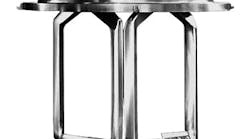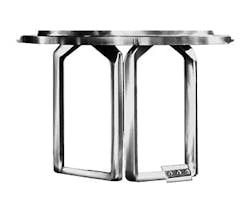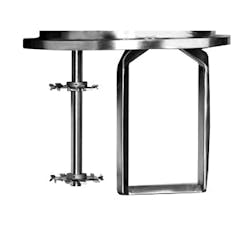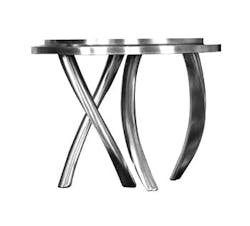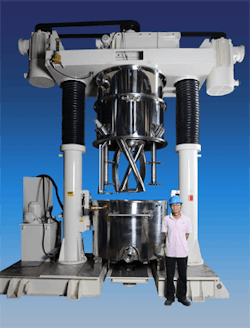Appreciate the Art of High Viscosity Mixing
Many processing operations require mixing of high-viscosity materials. Unfortunately, there’re no “cookbook” answers for reliably matching an application to an appropriate mixer. You can’t simply go to a chart, select an application or a viscosity and find the appropriate mixer design. High viscosity mixing is an art, not a science. Mixer specification isn’t straightforward and predictable; many variables affect the specification process.
On the equipment side, we now have many agitator designs to consider — from high-speed, high-shear devices to low-speed anchors and close-tolerance planetary blades. In addition, numerous possible combinations of agitators working in tandem or independently exist; these can be stationary or move in various patterns inside the mix vessel as they rotate on their own axes.
On the materials side, the variables are less numerous but more subjective. They often interact in complex and subtle ways to profoundly influence mixer selection.
Figure 1. Two rectangular stirrers that rotate on their own axes as they revolve on a common axis move through the batch continuously mixing materials up to about 2 million cP.
For example, viscosity may seem a straightforward measurement that should point to a particular type of mixer. However, in the real world of mixer specification, viscosity is not decisive. It’s just one of many co-dependent variables subject to interpretation.
Imagine two materials, each measuring 1 million cP on a viscometer at a specific shear rate. One is a common hair gel made with carbomers, gum thickeners and water; the other is a construction adhesive. We easily can mix the gel in a dual-shaft mixer with a stationary high-speed disperser and a slow-speed anchor agitator. However, the adhesive — because it’s a much stickier material — would require a much more powerful double planetary mixer.
The double planetary mixer (Figure 1) is designed to mix materials that are sticky and don’t flow easily. Its stirrers move through the batch in a planetary pattern while they rotate on their own axes. They physically transport material from the vessel walls into the vessel interior, mixing the batch thoroughly in only a few revolutions. This action promotes efficient dispersion — and, with bottom- and sidewall-scrapers added, efficient heat transfer as well.
Key Questions
These days, we can solve most mixing challenges with two or three different types of equipment. To find the optimal solution — not the only solution — the best course is to test a variety of equipment, not just the one that initially seems the most likely choice.
The selection process is intuitive. Although every formulation presents a unique set of mixing steps (e.g., high-solids dispersion or de-aeration), our process always begins with the same series of inter-related questions.
What is the viscosity, both peak and periodic? It’s important to specify the maximum viscosity of the mix materials during your process — and at key milestones during the mix cycle. A peak viscosity of 1 million cP, for example, suggests the need for either a planetary/disperser hybrid mixer or a double planetary mixer.
If a crucial dispersion takes place early in the cycle when viscosity is still quite low, we might consider combining a single planetary blade with a high-speed disperser blade. In this classic planetary/disperser hybrid (Figure 2), the high-speed disperser will disperse solids efficiently at viscosities up to 50,000 cP or so, and the planetary blade will motivate the batch later on when it’s heavily loaded and no longer flowable.
However, if the formulation demands dispersion when viscosity levels far exceed 50,000 cP — beyond the operating range of a high-speed disperser — a multi-shaft mixer or double planetary mixer may be a better choice. As viscosity increases, planetary blades become more and more effective at imparting shear and improving dispersions.
Figure 2. Unit combines a high-speed disperser and a rectangular or helical planetary blade that transports non-flowing, viscous materials from the sidewall to the high-shear device.
Is the material sticky or slippery? As we noted earlier, a sticky material at 1 million cP may require the power of a double planetary mixer while a slippery material may mix easily in a less costly multi-agitator mixer. For extremely sticky materials, we certainly would test a double planetary mixer with helical HV blades (Figure 3). As the helical planetary blades advance through the batch, they drive the sticky material forward and down, which prevents it from climbing the blades — a chronic problem with sticky materials.
Instead of applying the shear we need with high-speed devices, this mixer applies shear with close-tolerance planetary blades. Each time they pass one another and the vessel sidewall, the sliding action of the helical, swept-back blades imparts substantial shear.
How much shear intensity is required? Many fillers and pigments require intense shear to reach a high-quality dispersion. At viscosities from about 20,000 to 50,000 cP, this usually is provided by stationary agitators such as a high-shear rotor/stator mixer, a high-speed disperser, or a combination of the two. In a triple-shaft mixer, we add a slow-speed, 2- or 3-wing anchor agitator, which motivates a large batch and feeds material to the high-shear agitators (Figure 4); all agitators are independently controlled, which provides great flexibility during the mix cycle. This triple agitator combination will handle materials up to about 300,000–400,000 cP.
Some hard-to-disperse solids are most easily wetted out and dispersed using subsurface injection during a low-viscosity phase in the mix cycle. By injecting powders such as fumed silica directly into the high-shear zone of a submerged rotor/stator generator, we instantly disperse them into the surrounding batch. This method also eliminates the risk of forming agglomerates and “fish eyes” — a common problem when these solids are simply added to the surface of a liquid batch.
Figure 3. These blades, built to withstand the great stress of mixing viscous materials up to 8 million cP, prevent sticky materials from climbing upward into the planetary gearbox.
An alternative method for intensifying shear is to withhold liquid, elevate viscosity during most of the mix cycle, and switch to a planetary mixer. Elevating viscosity “artificially” intensifies shear and accelerates the mixing cycle. During a final letdown phase, we adjust viscosity to the target level for the end product.
Does the formulation contain shear-thinning materials? The presence of such materials can open new possibilities in mixer specification. For example, materials over 20,000 cP generally are considered inappropriate for a rotor/stator mixer. Yet a high-shear rotor/stator mixer may well be the mixer of choice even for a material measuring 100,000 cP — if it’s shear-thinning and, especially, if it’s slippery as well.
In applications like this one, we also may consider combining two high-shear agitators in a multi-shaft configuration with an anchor agitator. All agitators are individually controlled, so the high-shear agitators will be idle during later phases in which viscosity is elevated.
Are shear-sensitive materials involved? With high-energy, high-shear agitators, it’s easy to damage the fragile structure of a gel or the delicate microspheres in a syntactic foam product. We eliminate this risk by mixing fragile materials with a low-energy agitator — and often by delaying their addition until high-shear operations have been completed.
This scenario highlights the versatility we gain by combining several independently controlled agitators in a single mixer. During the high-shear phase, a high-speed rotor/stator mixer, high-speed disperser, or both in combination can be used to disperse ingredients that are not easily damaged, then turned off when fragile materials are added.
Figure 4. The 3-wing anchor stimulates greater flow in the mix vessel and moves material toward two stationary high-shear agitators, increasing their effective viscosity range.
Does the formulation include heat-sensitive materials? Viscosity also varies with changes in batch temperature; this often creates new options in mixer selection. In fact, adding heat is a common process strategy to make batch materials more flowable and, therefore, ideal for mixing using a cost-efficient multi-shaft mixer with stationary high-shear devices. One example is a shear-thinning lubricant that measures 300,000 cP at room temperature — far beyond the normal operating range of a rotor/stator mixer. Raising the batch temperature to 150°C enables this lubricant to be mixed quite effectively with a rotor/stator mixer.
In cases where exposure to heat may degrade or destroy ingredients, we need a different strategy. The alternative is mixing at room temperature — at a much higher viscosity — using a double planetary mixer rather than a multi-shaft mixer with fixed high-shear agitators. Once again, we may elevate viscosity during the cycle, depending upon our need for shear in certain phases, then let down the batch to reach the final viscosity.
Although the capital cost of a double planetary mixer generally exceeds that of a multi-shaft mixer of the same capacity, we will narrow the economic gap by eliminating the need for thermal jacketing on the mix vessel (or multiple vessels in a change-can configuration). We also gain accumulating energy savings over time.
Scale-Up Issues
An onsite analytical laboratory can prove particularly valuable as you conduct your tests. It allows you to adjust your testing on the fly — switching from one mixer design to another, evaluating various agitator combinations and speeds, etc. — in real time as you gather data.
Every process test presents a unique set of critical parameters. However, in general, the laboratory should be equipped to evaluate such parameters as viscosity, density, particle/droplet sizes and distribution, and fineness of grind.
To scale up successfully from laboratory testing to full-scale production, test in the largest capacity possible — as close as you can come to your production batch sizes. As a rule, we also recommend limiting your scale-up to a factor of 1:10. Working within these boundaries, with an accurate record of all key parameters and process steps during testing, scale-up usually is straightforward.
In fact, for mixers designed for high-volume, high-viscosity applications, the greatest challenges in scale-up occur behind the scenes — in engineering and manufacturing the mixers themselves. At viscosities over 1 million cP, a high-performance mixer must be engineered to withstand enormous mechanical stresses.
As production batch sizes rise, the engineering challenges increase exponentially. Simply making the mixer’s drive components, shafts and agitators larger in proportion to the mixer’s overall size won’t suffice. They must be 3D-modeled and subjected to finite element analysis to identify stress points and optimize their design, materials of construction, casting and fabrication. This due diligence is required to ensure the mixers truly can handle 24/7 operation in very large batch sizes. It also allows the designers to avoid having to add workaround support devices — such as a crossbar connecting the flights of a helical planetary agitator — that reduce the risk of a component failure but actually diminish mixing efficiency and drive up production costs.
The result is a new breed of massive planetary mixers equipped with extremely robust drive systems and helical agitators that already are proving their worth for lithium-ion battery production in China (see sidebar). The designs are highly evolved; many employ specialty steels in key components to deliver a long working life with minimal risk of interruptions in production.
The Future Of High-Viscosity Mixing
Global market forces will continue to spur ramped-up production in China and elsewhere in Asia — and high-viscosity mixers will get even bigger.
This is great news for U.S. companies manufacturing overseas because it will make their offshore manufacturing even more cost-efficient. Of course, it also will benefit Asian companies racing to answer demand in their home markets.
Meanwhile, product and process development will continue in the U.S., along with full-scale production in select product categories. In addition, U.S.-based processors will benefit from improvements in smaller mixers that result from engineering advances spurred by the development of the immense high-viscosity mixers on the line in China today. With greater power, strength and reliability, high-viscosity mixers are giving manufacturers more options than ever before to optimize production and profitability.
Batteries Power Drive To Massive Mixers
The strongly rising demand for lithium-ion (Li-ion) batteries is spurring big increases in production capacity in China. The equipment for a typical battery process line costs more than $30 million. The planetary/disperser hybrid mixers on the line commonly operate with batch sizes of 300 gallons or more (Figure 5) but 750-gallon planetary mixers are coming online soon and 1,000-gallon ones are not far off. Battery manufacturers are moving toward these extremely large batch sizes both to lower the risk of batch-to-batch inconsistency and to capture economies of scale.
Figure 5. This 300-gallon unit is used for lithium-ion battery production in China; 750-gallon mixers will be online soon and even larger devices are coming.
This process environment requires a high-viscosity mixer capable of delivering both great power and versatility. In the initial phase of Li-ion electrode production, known as dry kneading, the mixer must blend dense, nano-sized powders with its helical planetary blades. Four high-speed disperser blades also are turning at low rpm and moving through the batch in a planetary pattern, but the planetary blades are doing most of the work. Viscosity during this period exceeds 5 million cP.
Dry kneading continues for another hour with the addition of a small amount of adhesive binder. The helical blades push the sticky batch material down and forward, applying high shear as they advance through the vessel.
A solvent then is added. As viscosity falls, the batch becomes more flowable. Soon the planetary blades no longer are the primary source of shear. The independently driven high-speed disperser blades accelerate and disperse the pre-blended powder blend into the solvent. By the time the cycle is finished, after about four hours overall, the electrode slurry has been let down to a viscosity appropriate for coating — between 5,000 and 15,000 cP.
KEN LANGHORN is technical director of Charles Ross & Son Company, Hauppauge, NY. TOM DIGIANNURIO is vice president of engineering for Charles Ross & Son Company, Hauppauge, NY. GEORGE LU is general manager of Ross Wuxi Equipment Company, Wuxi, China. E-mail them at [email protected], [email protected] and [email protected].
